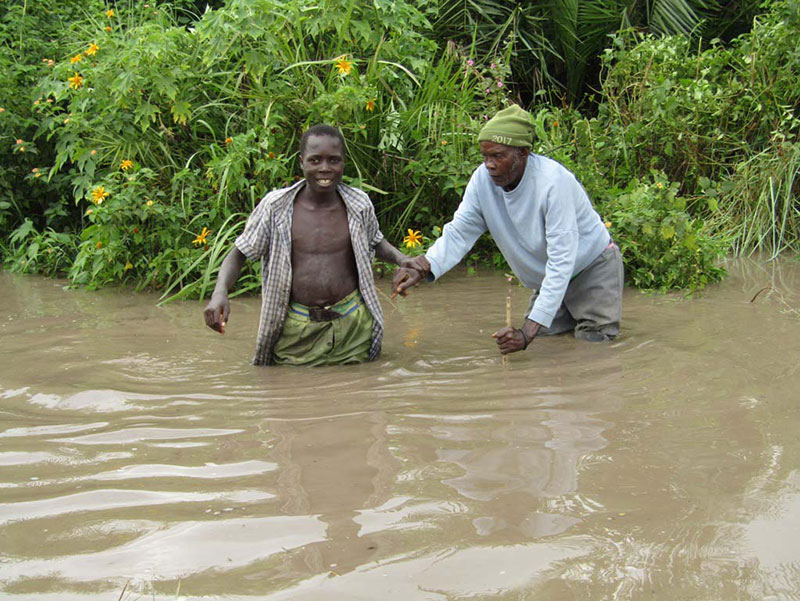Lake Victoria’s waters are advancing. After months of rainfall, the great African lake has risen a meter since October.
Although the rain is set to continue through August, the lake’s rise is also due to increased runoff caused by human activities around Lake Victoria and the rivers that feed it.
Lake Victoria is a huge transboundary body shared by Kenya, Tanzania, and Uganda. Twenty-three rivers feed the lake. Some of these rivers originate hundreds of kilometers away; when it rains in Burundi, water finds its way to Lake Victoria.
“The rivers discharging water into Lake Victoria from upstream countries have more than doubled their inflows,” in part because of heavy rains.
“The rivers discharging water into Lake Victoria from upstream countries have more than doubled their inflows,” in part because of heavy rains, said Sam Cheptoris, Uganda’s minister of water and environment. Lake Victoria has only one outlet, the White Nile. “This water flows through South Sudan, Sudan and ends up in the Mediterranean Sea through Egypt,” Cheptoris said. Water releases at Jinja (the headwaters of the Nile in Uganda) have increased to 2,200 cubic meters per second, up from 1,000 cubic meters per second last October.
Human Impacts on Water
“Uganda faced the same [amount of] rainfall between 1961 to 1964 and 1996 to 1998, which resulted in a rise in the levels of rivers and lakes” in the region, Cheptoris said, but the current situation has been worsened by environmental degradation and urbanization associated with drought in 2016–2017. Many Ugandans, 80% of whom rely on agriculture for their livelihoods, were forced to relocate to the shores of Lake Victoria or find work in industries such as forestry and fishing.

These human activities have accelerated the quick rise in Victoria’s waters, said Alfred Okot Okidi, the permanent secretary of the Ugandan Ministry of Water and Environment. “Loss of forest cover, encroachment on wetlands, lakeshores, and river banks, including poor land use practices, have resulted in soil erosion, leading to siltation of our water bodies,” he said.
Okidi added that urbanization has increased the amount of impermeable surfaces such as roads, roofs, and pavements, reducing water penetration into the soil and increasing the amount of runoff flowing to storm drains and other discharges. Urbanization has also reduced the evapotranspiration capacity of forests and wetlands surrounding Lake Victoria.
Water Impacts on Humans
As the lake’s level has risen, essential facilities such as drinking water and sanitation systems, health facilities, roads, and even hydropower stations have been affected. Water-related diseases such as cholera, dysentery, malaria, and schistosomiasis could increase, said Charles Olaro, director of clinical services for the Ugandan Ministry of Health. “The rise of Lake Victoria is worrying. We are struggling to contain the spread of coronavirus. It will drain the already stressed health system that is operating on minimal funds.”
Recently, the increased water level dislodged papyrus mats from shorelines, resulting in huge floating plant islands, which threaten hydropower infrastructure. In mid-April, one such papyrus mass docked at Nalubaale Hydro Power Station, choking turbines and resulting in a temporary Ugandan-wide power blackout.
“These floating islands, too, have the capacity to block waterways and other economic activities within the water bodies,” said Okidi. Further downstream, ferries along the Nile River have been suspended, as jetties and landing sites have been submerged.
Okidi said that since the water started rising, over 200,000 people have been displaced and left homeless. Property worth millions of Ugandan shillings has been destroyed, from homes to large shoreline resorts.

Next Steps
Earlier this month, Uganda’s central government threatened to fire officials who had not taken action against people building in sensitive areas around the lake. The water ministry evicted people who had settled within the protected zones of wetlands, lakes, rivers, and forest reserves.
According to the Ugandan Ministry of Water and Environmental policy, people must settle 100 meters away from river banks, 30 meters away from wetlands, and 200 meters from lake shores. Cultivation on steep slopes also must come to a halt to reduce erosion and high runoff from hilly areas.
Dora Byamukama, one of Uganda’s members of parliament in the East African Legislative Assembly (EALA), said countries sharing Lake Victoria have similar regulations, instituted by each country’s respective National Environment Management Authority in consultation with EALA.
Human impacts, nevertheless, are expected to continue from activities like sand mining, forestry, and agriculture, which all use water from or encroach on the lake. Threats from climate change, such as more frequent instances of the El Niño–Southern Oscillation, also continue to disturb the shores of Lake Victoria, said Revocatus Twinomuhangi in the Department of Geography, Geo-Informatics and Climatic Sciences at Makerere University in Kampala, Uganda.
“Climate change is becoming [more of] a reality than ever before, and if we do not stop human activities along the lakeshores, water catchment areas, and reserve forests, we are heading to some disasters that [African countries] have no resources to handle,” Twinomuhangi warned.
—Hope Mafaranga (@mafaranga), Science Writer
Citation:
Mafaranga, H. (2020), Heavy rains, human activity, and rising waters at Lake Victoria, Eos, 101, https://doi.org/10.1029/2020EO146582. Published on 07 July 2020.
Text © 2020. The authors. CC BY-NC-ND 3.0
Except where otherwise noted, images are subject to copyright. Any reuse without express permission from the copyright owner is prohibited.

